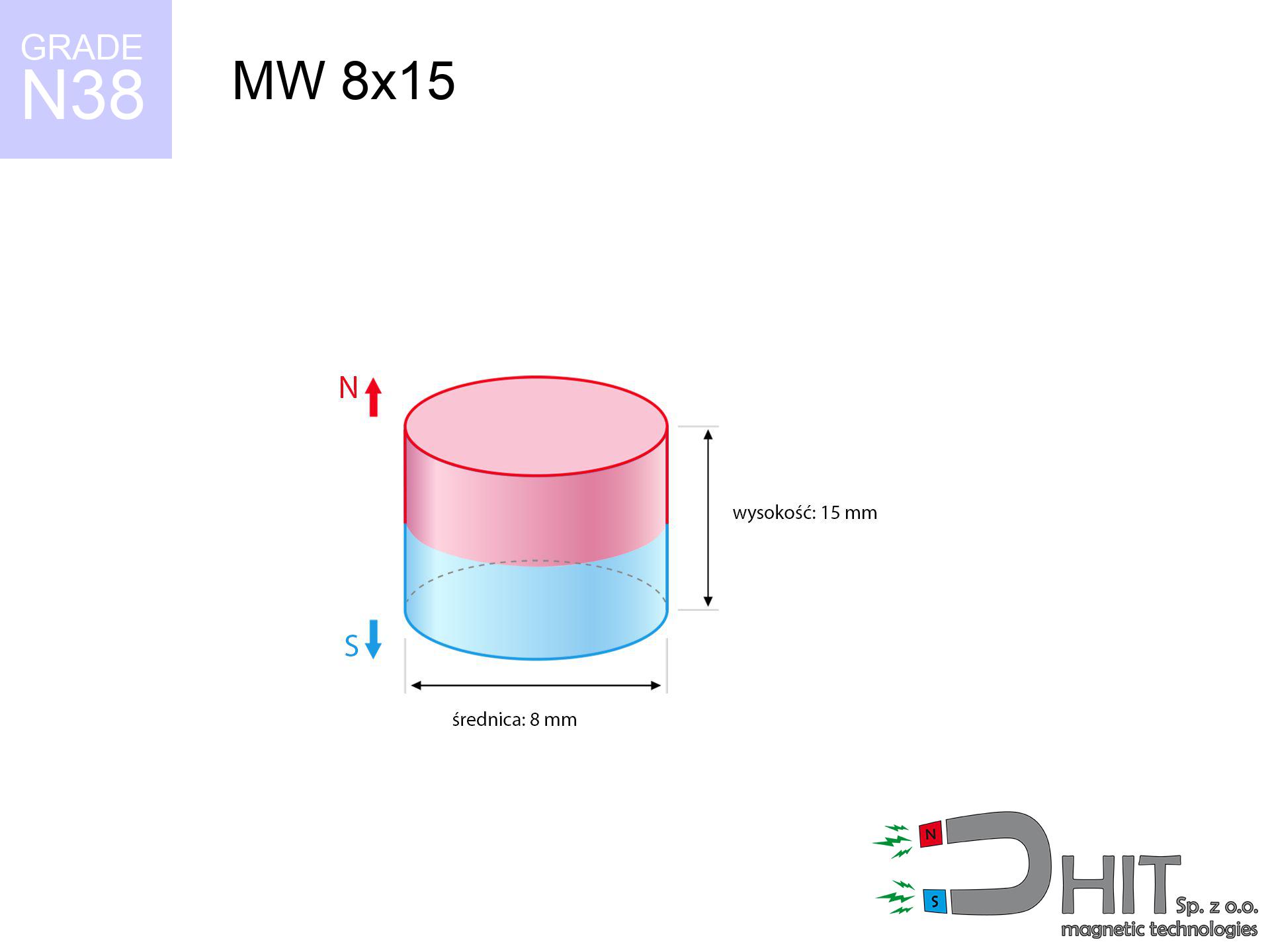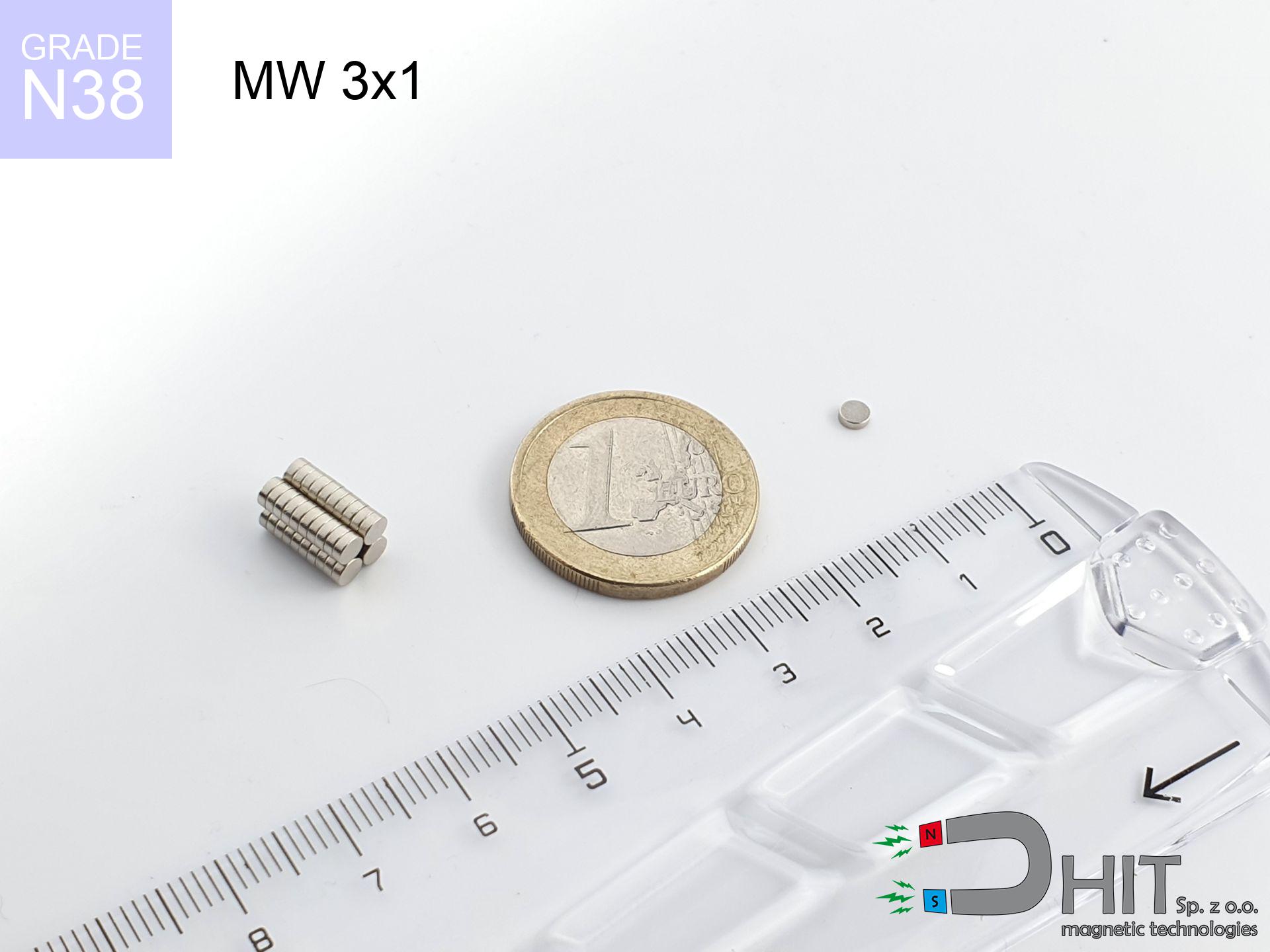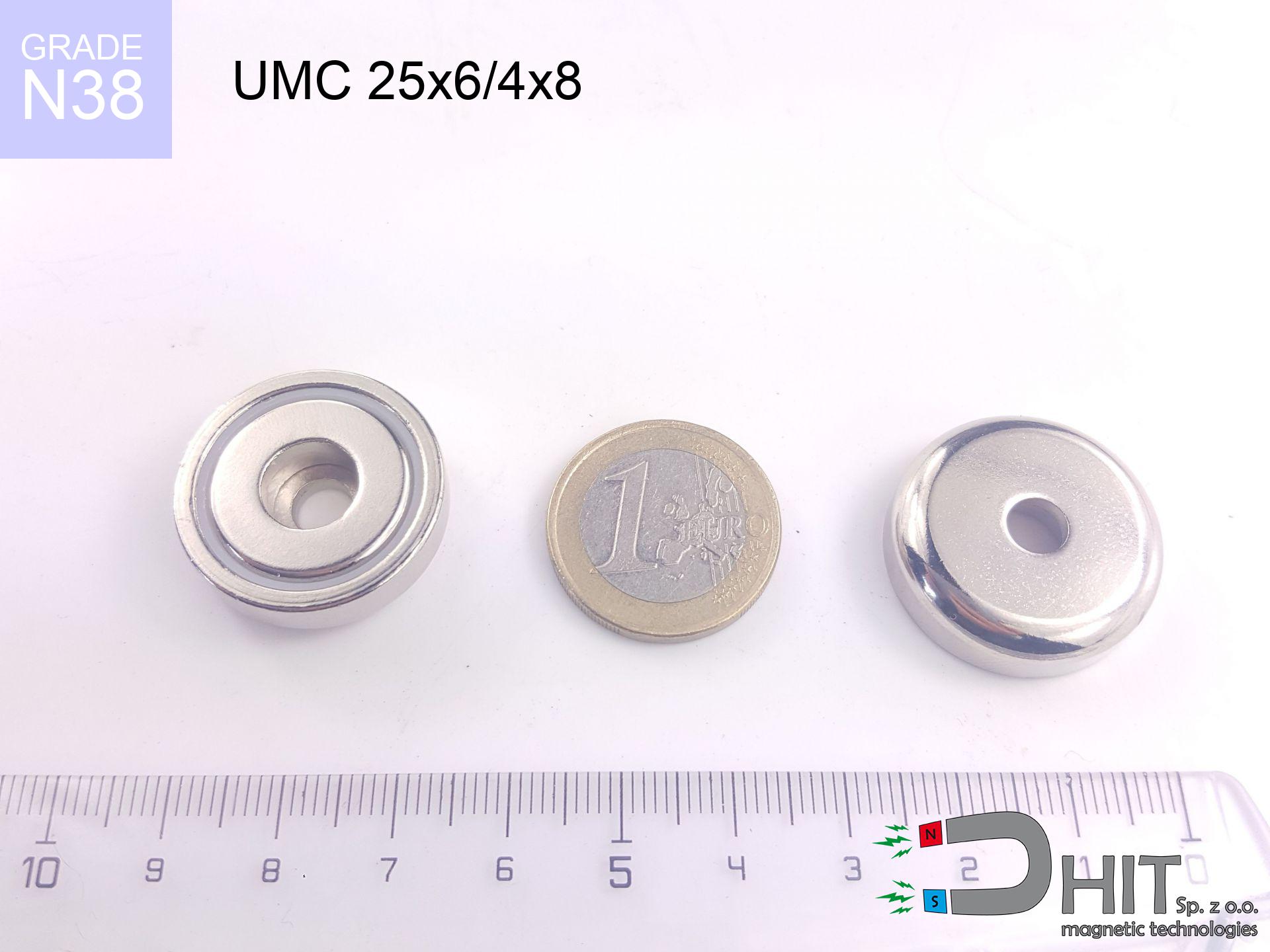MW 8x15 / N38 - cylindrical magnet
cylindrical magnet
Catalog no 010102
GTIN/EAN: 5906301811015
Diameter Ø
8 mm [±0,1 mm]
Height
15 mm [±0,1 mm]
Weight
5.65 g
Magnetization Direction
↑ axial
Load capacity
1.47 kg / 14.45 N
Magnetic Induction
598.12 mT / 5981 Gs
Coating
[NiCuNi] Nickel
3.44 ZŁ with VAT / pcs + price for transport
2.80 ZŁ net + 23% VAT / pcs
bulk discounts:
Need more?
Pick up the phone and ask
+48 888 99 98 98
or send us a note through
inquiry form
through our site.
Lifting power along with structure of a magnet can be analyzed on our
force calculator.
Same-day shipping for orders placed before 14:00.
Technical data of the product - MW 8x15 / N38 - cylindrical magnet
Specification / characteristics - MW 8x15 / N38 - cylindrical magnet
| properties | values |
|---|---|
| Cat. no. | 010102 |
| GTIN/EAN | 5906301811015 |
| Production/Distribution | Dhit sp. z o.o. |
| Country of origin | Poland / China / Germany |
| Customs code | 85059029 |
| Diameter Ø | 8 mm [±0,1 mm] |
| Height | 15 mm [±0,1 mm] |
| Weight | 5.65 g |
| Magnetization Direction | ↑ axial |
| Load capacity ~ ? | 1.47 kg / 14.45 N |
| Magnetic Induction ~ ? | 598.12 mT / 5981 Gs |
| Coating | [NiCuNi] Nickel |
| Manufacturing Tolerance | ±0.1 mm |
Magnetic properties of material N38
| properties | values | units |
|---|---|---|
| remenance Br [min. - max.] ? | 12.2-12.6 | kGs |
| remenance Br [min. - max.] ? | 1220-1260 | mT |
| coercivity bHc ? | 10.8-11.5 | kOe |
| coercivity bHc ? | 860-915 | kA/m |
| actual internal force iHc | ≥ 12 | kOe |
| actual internal force iHc | ≥ 955 | kA/m |
| energy density [min. - max.] ? | 36-38 | BH max MGOe |
| energy density [min. - max.] ? | 287-303 | BH max KJ/m |
| max. temperature ? | ≤ 80 | °C |
Physical properties of sintered neodymium magnets Nd2Fe14B at 20°C
| properties | values | units |
|---|---|---|
| Vickers hardness | ≥550 | Hv |
| Density | ≥7.4 | g/cm3 |
| Curie Temperature TC | 312 - 380 | °C |
| Curie Temperature TF | 593 - 716 | °F |
| Specific resistance | 150 | μΩ⋅cm |
| Bending strength | 250 | MPa |
| Compressive strength | 1000~1100 | MPa |
| Thermal expansion parallel (∥) to orientation (M) | (3-4) x 10-6 | °C-1 |
| Thermal expansion perpendicular (⊥) to orientation (M) | -(1-3) x 10-6 | °C-1 |
| Young's modulus | 1.7 x 104 | kg/mm² |
Engineering analysis of the assembly - report
Presented data constitute the direct effect of a mathematical simulation. Values were calculated on algorithms for the class Nd2Fe14B. Actual parameters may differ. Please consider these calculations as a supplementary guide when designing systems.
Table 1: Static pull force (pull vs gap) - characteristics
MW 8x15 / N38
| Distance (mm) | Induction (Gauss) / mT | Pull Force (kg) | Risk Status |
|---|---|---|---|
| 0 mm |
5975 Gs
597.5 mT
|
1.47 kg / 1470.0 g
14.4 N
|
safe |
| 1 mm |
4511 Gs
451.1 mT
|
0.84 kg / 837.8 g
8.2 N
|
safe |
| 2 mm |
3262 Gs
326.2 mT
|
0.44 kg / 438.2 g
4.3 N
|
safe |
| 3 mm |
2332 Gs
233.2 mT
|
0.22 kg / 224.0 g
2.2 N
|
safe |
| 5 mm |
1238 Gs
123.8 mT
|
0.06 kg / 63.1 g
0.6 N
|
safe |
| 10 mm |
366 Gs
36.6 mT
|
0.01 kg / 5.5 g
0.1 N
|
safe |
| 15 mm |
155 Gs
15.5 mT
|
0.00 kg / 1.0 g
0.0 N
|
safe |
| 20 mm |
80 Gs
8.0 mT
|
0.00 kg / 0.3 g
0.0 N
|
safe |
| 30 mm |
30 Gs
3.0 mT
|
0.00 kg / 0.0 g
0.0 N
|
safe |
| 50 mm |
8 Gs
0.8 mT
|
0.00 kg / 0.0 g
0.0 N
|
safe |
Table 2: Sliding force (vertical surface)
MW 8x15 / N38
| Distance (mm) | Friction coefficient | Pull Force (kg) |
|---|---|---|
| 0 mm | Stal (~0.2) |
0.29 kg / 294.0 g
2.9 N
|
| 1 mm | Stal (~0.2) |
0.17 kg / 168.0 g
1.6 N
|
| 2 mm | Stal (~0.2) |
0.09 kg / 88.0 g
0.9 N
|
| 3 mm | Stal (~0.2) |
0.04 kg / 44.0 g
0.4 N
|
| 5 mm | Stal (~0.2) |
0.01 kg / 12.0 g
0.1 N
|
| 10 mm | Stal (~0.2) |
0.00 kg / 2.0 g
0.0 N
|
| 15 mm | Stal (~0.2) |
0.00 kg / 0.0 g
0.0 N
|
| 20 mm | Stal (~0.2) |
0.00 kg / 0.0 g
0.0 N
|
| 30 mm | Stal (~0.2) |
0.00 kg / 0.0 g
0.0 N
|
| 50 mm | Stal (~0.2) |
0.00 kg / 0.0 g
0.0 N
|
Table 3: Wall mounting (sliding) - behavior on slippery surfaces
MW 8x15 / N38
| Surface type | Friction coefficient / % Mocy | Max load (kg) |
|---|---|---|
| Raw steel |
µ = 0.3
30% Nominalnej Siły
|
0.44 kg / 441.0 g
4.3 N
|
| Painted steel (standard) |
µ = 0.2
20% Nominalnej Siły
|
0.29 kg / 294.0 g
2.9 N
|
| Oily/slippery steel |
µ = 0.1
10% Nominalnej Siły
|
0.15 kg / 147.0 g
1.4 N
|
| Magnet with anti-slip rubber |
µ = 0.5
50% Nominalnej Siły
|
0.74 kg / 735.0 g
7.2 N
|
Table 4: Material efficiency (saturation) - power losses
MW 8x15 / N38
| Steel thickness (mm) | % power | Real pull force (kg) |
|---|---|---|
| 0.5 mm |
|
0.15 kg / 147.0 g
1.4 N
|
| 1 mm |
|
0.37 kg / 367.5 g
3.6 N
|
| 2 mm |
|
0.74 kg / 735.0 g
7.2 N
|
| 5 mm |
|
1.47 kg / 1470.0 g
14.4 N
|
| 10 mm |
|
1.47 kg / 1470.0 g
14.4 N
|
Table 5: Working in heat (material behavior) - thermal limit
MW 8x15 / N38
| Ambient temp. (°C) | Power loss | Remaining pull | Status |
|---|---|---|---|
| 20 °C | 0.0% |
1.47 kg / 1470.0 g
14.4 N
|
OK |
| 40 °C | -2.2% |
1.44 kg / 1437.7 g
14.1 N
|
OK |
| 60 °C | -4.4% |
1.41 kg / 1405.3 g
13.8 N
|
OK |
| 80 °C | -6.6% |
1.37 kg / 1373.0 g
13.5 N
|
|
| 100 °C | -28.8% |
1.05 kg / 1046.6 g
10.3 N
|
Table 6: Magnet-Magnet interaction (repulsion) - field collision
MW 8x15 / N38
| Gap (mm) | Attraction (kg) (N-S) | Repulsion (kg) (N-N) |
|---|---|---|
| 0 mm |
11.06 kg / 11065 g
108.5 N
6 130 Gs
|
N/A |
| 1 mm |
8.49 kg / 8490 g
83.3 N
10 469 Gs
|
7.64 kg / 7641 g
75.0 N
~0 Gs
|
| 2 mm |
6.31 kg / 6306 g
61.9 N
9 022 Gs
|
5.68 kg / 5676 g
55.7 N
~0 Gs
|
| 3 mm |
4.59 kg / 4590 g
45.0 N
7 697 Gs
|
4.13 kg / 4131 g
40.5 N
~0 Gs
|
| 5 mm |
2.36 kg / 2357 g
23.1 N
5 516 Gs
|
2.12 kg / 2122 g
20.8 N
~0 Gs
|
| 10 mm |
0.48 kg / 475 g
4.7 N
2 476 Gs
|
0.43 kg / 428 g
4.2 N
~0 Gs
|
| 20 mm |
0.04 kg / 41 g
0.4 N
731 Gs
|
0.04 kg / 37 g
0.4 N
~0 Gs
|
| 50 mm |
0.00 kg / 1 g
0.0 N
94 Gs
|
0.00 kg / 0 g
0.0 N
~0 Gs
|
Table 7: Protective zones (implants) - warnings
MW 8x15 / N38
| Object / Device | Limit (Gauss) / mT | Safe distance |
|---|---|---|
| Pacemaker | 5 Gs (0.5 mT) | 6.0 cm |
| Hearing aid | 10 Gs (1.0 mT) | 5.0 cm |
| Mechanical watch | 20 Gs (2.0 mT) | 4.0 cm |
| Phone / Smartphone | 40 Gs (4.0 mT) | 3.0 cm |
| Car key | 50 Gs (5.0 mT) | 2.5 cm |
| Payment card | 400 Gs (40.0 mT) | 1.0 cm |
| HDD hard drive | 600 Gs (60.0 mT) | 1.0 cm |
Table 8: Collisions (kinetic energy) - warning
MW 8x15 / N38
| Start from (mm) | Speed (km/h) | Energy (J) | Predicted outcome |
|---|---|---|---|
| 10 mm |
16.31 km/h
(4.53 m/s)
|
0.06 J | |
| 30 mm |
28.18 km/h
(7.83 m/s)
|
0.17 J | |
| 50 mm |
36.37 km/h
(10.10 m/s)
|
0.29 J | |
| 100 mm |
51.44 km/h
(14.29 m/s)
|
0.58 J |
Table 9: Surface protection spec
MW 8x15 / N38
| Technical parameter | Value / Description |
|---|---|
| Coating type | [NiCuNi] Nickel |
| Layer structure | Nickel - Copper - Nickel |
| Layer thickness | 10-20 µm |
| Salt spray test (SST) ? | 24 h |
| Recommended environment | Indoors only (dry) |
Table 10: Electrical data (Flux)
MW 8x15 / N38
| Parameter | Value | SI Unit / Description |
|---|---|---|
| Magnetic Flux | 3 306 Mx | 33.1 µWb |
| Pc Coefficient | 1.19 | High (Stable) |
Table 11: Hydrostatics and buoyancy
MW 8x15 / N38
| Environment | Effective steel pull | Effect |
|---|---|---|
| Air (land) | 1.47 kg | Standard |
| Water (riverbed) |
1.68 kg
(+0.21 kg Buoyancy gain)
|
+14.5% |
1. Sliding resistance
*Warning: On a vertical surface, the magnet retains only a fraction of its nominal pull.
2. Steel thickness impact
*Thin steel (e.g. computer case) severely limits the holding force.
3. Temperature resistance
*For N38 grade, the safety limit is 80°C.
4. Demagnetization curve and operating point (B-H)
chart generated for the permeance coefficient Pc (Permeance Coefficient) = 1.19
This simulation demonstrates the magnetic stability of the selected magnet under specific geometric conditions. The solid red line represents the demagnetization curve (material potential), while the dashed blue line is the load line based on the magnet's geometry. The Pc (Permeance Coefficient), also known as the load line slope, is a dimensionless value that describes the relationship between the magnet's shape and its magnetic stability. The intersection of these two lines (the black dot) is the operating point — it determines the actual magnetic flux density generated by the magnet in this specific configuration. A higher Pc value means the magnet is more 'slender' (tall relative to its area), resulting in a higher operating point and better resistance to irreversible demagnetization caused by external fields or temperature. A value of 0.42 is relatively low (typical for flat magnets), meaning the operating point is closer to the 'knee' of the curve — caution is advised when operating at temperatures near the maximum limit to avoid strength loss.
Elemental analysis
| iron (Fe) | 64% – 68% |
| neodymium (Nd) | 29% – 32% |
| boron (B) | 1.1% – 1.2% |
| dysprosium (Dy) | 0.5% – 2.0% |
| coating (Ni-Cu-Ni) | < 0.05% |
Sustainability
| recyclability (EoL) | 100% |
| recycled raw materials | ~10% (pre-cons) |
| carbon footprint | low / zredukowany |
| waste code (EWC) | 16 02 16 |
Check out more proposals
Advantages as well as disadvantages of rare earth magnets.
Pros
- They virtually do not lose strength, because even after 10 years the performance loss is only ~1% (according to literature),
- They retain their magnetic properties even under external field action,
- A magnet with a metallic nickel surface has an effective appearance,
- They feature high magnetic induction at the operating surface, making them more effective,
- Due to their durability and thermal resistance, neodymium magnets are capable of operate (depending on the form) even at high temperatures reaching 230°C or more...
- Considering the ability of accurate forming and customization to unique needs, neodymium magnets can be created in a variety of shapes and sizes, which amplifies use scope,
- Wide application in high-tech industry – they are commonly used in mass storage devices, drive modules, medical equipment, as well as other advanced devices.
- Compactness – despite small sizes they provide effective action, making them ideal for precision applications
Weaknesses
- At very strong impacts they can crack, therefore we recommend placing them in strong housings. A metal housing provides additional protection against damage and increases the magnet's durability.
- We warn that neodymium magnets can reduce their strength at high temperatures. To prevent this, we suggest our specialized [AH] magnets, which work effectively even at 230°C.
- When exposed to humidity, magnets usually rust. For applications outside, it is recommended to use protective magnets, such as magnets in rubber or plastics, which prevent oxidation and corrosion.
- We suggest a housing - magnetic mount, due to difficulties in realizing threads inside the magnet and complex shapes.
- Potential hazard resulting from small fragments of magnets are risky, if swallowed, which is particularly important in the context of child health protection. Additionally, tiny parts of these devices are able to be problematic in diagnostics medical after entering the body.
- Higher cost of purchase is a significant factor to consider compared to ceramic magnets, especially in budget applications
Lifting parameters
Maximum lifting force for a neodymium magnet – what contributes to it?
- on a base made of mild steel, optimally conducting the magnetic flux
- whose transverse dimension reaches at least 10 mm
- characterized by smoothness
- with direct contact (without paint)
- under axial force direction (90-degree angle)
- at temperature room level
Lifting capacity in practice – influencing factors
- Distance – existence of any layer (paint, dirt, gap) acts as an insulator, which lowers capacity steeply (even by 50% at 0.5 mm).
- Direction of force – highest force is available only during perpendicular pulling. The shear force of the magnet along the plate is usually several times smaller (approx. 1/5 of the lifting capacity).
- Steel thickness – insufficiently thick steel does not close the flux, causing part of the power to be lost into the air.
- Plate material – mild steel attracts best. Higher carbon content lower magnetic properties and holding force.
- Surface quality – the smoother and more polished the surface, the better the adhesion and higher the lifting capacity. Roughness creates an air distance.
- Temperature influence – high temperature reduces magnetic field. Exceeding the limit temperature can permanently demagnetize the magnet.
Holding force was checked on a smooth steel plate of 20 mm thickness, when a perpendicular force was applied, however under attempts to slide the magnet the lifting capacity is smaller. Moreover, even a minimal clearance between the magnet’s surface and the plate lowers the holding force.
Safety rules for work with NdFeB magnets
Do not underestimate power
Before use, check safety instructions. Sudden snapping can break the magnet or hurt your hand. Think ahead.
Maximum temperature
Control the heat. Heating the magnet above 80 degrees Celsius will destroy its properties and pulling force.
Fragile material
NdFeB magnets are sintered ceramics, meaning they are fragile like glass. Impact of two magnets leads to them cracking into shards.
Warning for allergy sufferers
Warning for allergy sufferers: The Ni-Cu-Ni coating contains nickel. If an allergic reaction happens, cease handling magnets and wear gloves.
Data carriers
Avoid bringing magnets close to a purse, laptop, or screen. The magnetism can permanently damage these devices and wipe information from cards.
Precision electronics
Navigation devices and smartphones are highly susceptible to magnetism. Direct contact with a strong magnet can permanently damage the sensors in your phone.
Warning for heart patients
Patients with a pacemaker should maintain an absolute distance from magnets. The magnetism can interfere with the operation of the life-saving device.
Physical harm
Risk of injury: The attraction force is so immense that it can cause hematomas, pinching, and even bone fractures. Use thick gloves.
Choking Hazard
Adult use only. Small elements can be swallowed, causing serious injuries. Store away from kids and pets.
Dust explosion hazard
Combustion risk: Rare earth powder is explosive. Do not process magnets in home conditions as this risks ignition.





![UMGZ 25x17x8 [M5] GZ / N38 - magnetic holder external thread UMGZ 25x17x8 [M5] GZ / N38 - magnetic holder external thread](https://cdn3.dhit.pl/graphics/products/um-25x17x8-m5-gz-keb.jpg)



